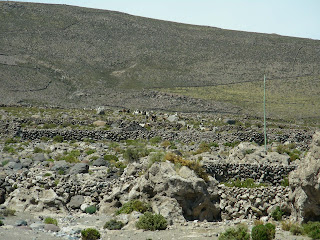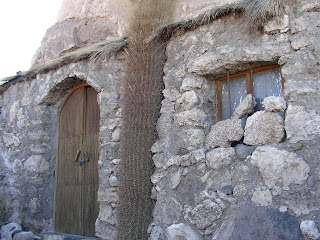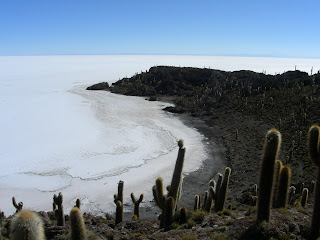We debated briefly about going on a tour of the Salar de Uyuni, the world's largest salt lake/flat/thing. After reading several guidebooks, blogs, and talking to folks who had taken the tour--all declaring it "the most amazing thing" ever to be seen by human eyes--we figured we should go. For Bolivia, this kind of tour is expensive, but for a tour in general they run pretty cheap.
We read that the best thing to do is just show up in Uyuni and start tour shopping. Every tour operator (and there are about 70 of them) does essentially the same tour, so the goal is to find one with the little differences that skew in your favor. For some, this is an English speaking guide. For some, this is particular accommodations. For us, it was less about finding a tour operator and more about finding some tourists. We wanted to do the 4-day tour, while the standard is a 3-day tour. We also wanted to only have 4 of us in the car, vs. the normal 6. This made us something of a rarity. After visiting 6 or 8 tour operators and realizing that this was the barrier, we started stalking gringos. This is fairly easy to do, though it makes one feel a little creepy. We made a sign "Looking for 2 more people for a 4-day tour", walked around, and accosted passersby. Around noon, after no luck, we gave up for awhile and decided to wait for the afternoon buses to come in. At 5 the buses start arriving again and we went fishing. At some point we actually hit every gringo in town and started doubling back, realizing this only when one of us was given a description of the other for "someone else was looking for a 4-day tour too". Oops.
After a long and hot day in the very boring and dusty town of Uyuni, we wandered back into the only tour operator who seemed to think it plausible that we could in fact find others for a 4-day tour: Blue Line. We were discussing our chances when two young European women walked in. After some cajoling, we all decided to do the 4-day tour. Hooray! We went for a celebratory beer, and as we walked through the square we got some congratulations from the random strangers we met for finding another pair for our tour. We had perhaps become a public nuisance. [Shop owners who didn't speak English did stop us to ask what our sign said. At least we were infamous, if not famous, in Uyuni that day.]
So we had one last dinner at our rather nice hotel, Tonito, which also houses the "best" restaurant in town: a pizza joint. The owner is from western Massachusetts, so the pizza is actually quite good. The breakfast there is included with the room and is a buffet of also rather good stuff, including American pancakes! ["pancake" often translates to "crepe" here.] We also enjoyed the cactus chairs, tables, and chair-rails that served as furniture. Use what you've got? Our tour left in the late morning the next day.
The details of the route are kind of boring, and as mentioned everyone does the same thing. The one difference was our extra day, which got us to visit the Vulcan Thunupa on the north end of the salar. Otherwise we did the same stuff: train cemetary, salt processing and chotski stands, salt hotel/museum, Isla Incahuasi, San Juan, altiplano lagunas, deserts, and sightseeing in the Reserva before crossing the border into Chile. So, pictures instead.
Here is the obligatory image of the old and rusting trains on the tracks to Antofagasta. Uyuni used to be a major rail hub. Now it's a tourist hub.
Here are the salt piles made by the workers. Once the piles are dry (the salt contains a fair bit of water), they are scooped up, piled on a truck, and brought back to the village for processing.
A little way into the salar itself is an old hotel made of salt bricks. Props for local building material! These hotels on the salar are now illegal, and now this one is a museum and a place where tours stop for lunch. The sign might seem unnecessary, but in reality it is tempting.
The salar itself is massive, but so large that it actually gets a little boring driving across it. Look, more salt! We did hit the beginning of the wet season, so portions of the salar were flooded. This made driving a bit slow (and some companies refused to cross the salar at all due to the corrosive saltwater) but also created a very cool mirror in the few-inches deep water.
Our favorite parts of the salar were the things around it that were not the salar, perhaps because it gave you something else to look at. The whole area is rimmed with quinoa farms and llama ranchers, which is a little weird considering how little water there is available most of the year. We encountered a very playful baby llama.
There are several islands within the salar, one of which we visited: Incahuasi. It was a cool place with cactus growing on an old coral atoll. How strange is that? The edges (shores?) of the island looked like frozen beaches, with the white salt permanently stuck almost washing ashore.
We also got to see sunrise on the salar. We had been wearing sunglasses all the previous day, but we figured sunrise is pretty tame in terms of blinding light. Not so! It was by far the brightest sunrise ever. And cold; the salar is quite freezing at night and the sun doesn't do much to warm it up. Looking away from the sun across the salar is blinding, and looking anywhere near the direction of the sun without sunglasses is like stabbing your eyes with red-hot pokers. It's the whitest object we've ever attempted to view.
After leaving the salar, we spent the night in San Juan, a little town of seemingly no consequence other than as a stop for tour groups. Our hotel had a stone foundation surmounted by salt bricks held together by salt mortar. [salt hotels off the salar are legal.] The floor was also crushed salt, which got everywhere and was kind of annoying. After breakfast at the salt tables we headed south across the desert, stopping occasionally at the typically tourist spots along with the long line of LandCruisers before and behind us. We did see a lot of vicunas and flamencos. The big draw of the day was the several altiplano lakes, often rimmed with borax and stained odd colors by either minerals or algae, and in some cases had some steaming volcanic spring action complete with the lovely sulfur odor. Lots of flamencos. Also an obligatory stop with a view of a volcano sporting a slightly smoking summit and at the Arbol de Piedra [stone tree], which frankly doesn't look much like a tree but is neat anyway. We spent the night at 4300 m near Laguna Colorada, a red lake full of phytoplankton that the flamingos eat.
The next day we got up at 4, along with everyone else in town, in order to visit the geysers. Our guide Edgar told us to be packed in the car at 4:30, and we were, but we didn't leave. Edgar was nowhere to be found. Eventually we did find him and we got going around 5am. We're not really sure what the deal is with seeing the geysers at sunrise, other than as a way to get you either to Chile or back to Uyuni before too late in the afternoon (most guides will have another group the next day). But there we were, at 4900 m, freezing our asses off in the predawn looking at some steaming rocks. By the time the sun came up fully we were on our way to the last few stops: hot springs, more rocks in the desert billed at the Salvador Dali Desert (no idea why), and a couple more colored lakes (Blanca y Verde).
We got to the Bolivian side of the border at 8:20, and our bus to San Pedro was supposed to be there at 9. We were told sometimes the bus is late since it comes through Argentina first. Great. We wound up stuck at the border, sitting at 4000 or so meters and totally exposed to the very cold wind, for 3 hours. Edgar left after about 40 minutes with a carload of locals going back to Uyuni. Our bus finally got there, last of all the transfer buses (we had tickets for a particular bus ahead of time, seemed like a good idea), and then we got to watch the people getting off the bus eat breakfast for half an hour. WTF? Well anyway we eventually got on, filled out lots of forms, and drove to Chile.
The guidebooks say this particular border crossing is easy. Technically it was, we had no real problems. However, we were stuck at the Chilean immigration office for 4 hours. There were 2 buses ahead of us (one of which arrived after us, but it's best if we just don't talk about that part), but really that's only like 75 people. Slowest. Border. Ever.
Got our hotel in San Pedro, got some Chilean pesos, and got some drinks. Un largo dia. We're also getting a bit chafed by the dry air. San Pedro de Atacama, being of course in the Atacama desert, doesn't seem like a good place to recover our skin moisture. Hopefully sunscreen counts.










































Now that's what I call a tour fix.
ReplyDeletesluntz@earthlink.net
Wow, the salar looks so otherworldly...and then you get a llama.
ReplyDeleteGlad to see that you guys are having a awesome adventure.
-Caroline
Hahaha, the llama. There were 2 resident llamas on Isla Incahuasi. Not sure what they do there, but they did run around on the salar a lot. Maybe all that whiteness makes them crazy?
ReplyDeleteimagenes muy lindas viva Bolivia viva Oruro viva Marka Salinas
ReplyDelete